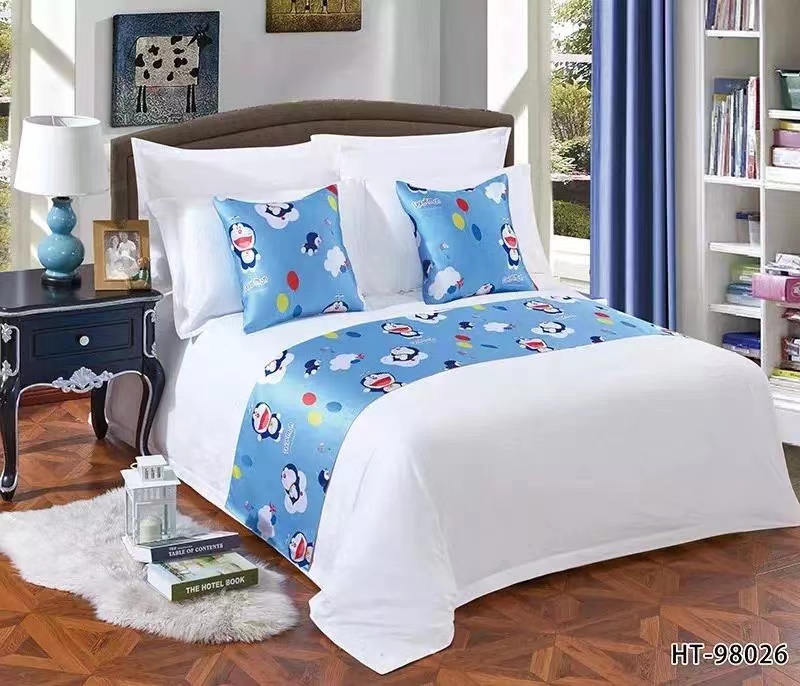不同的纖維及其織物都會存在不同程度的縮水。酒店布草的面料多為純棉、滌棉和絲綢,這三種材料制成的布草都會存在一定程度的縮水。根據相關的國家標準,縮水率應在3%-4%,但一些質量較差的產品可能會達到8%-10%.
Different fibers and their fabrics will experience varying degrees of shrinkage. The fabric of hotel linen is mostly pure cotton, polyester cotton, and silk, and the linen made of these three materials will have a certain degree of shrinkage. According to relevant national standards, the shrinkage rate should be between 3% -4%, but some products with poor quality may reach 8% -10%
布草中的纖維在制造時,會受到外力作用產生變形,呈現出靜態干松弛、靜態干松弛、動態濕松弛、全松弛等狀態,從而使布草長度變長。布草在洗滌的過程中,再次受到外力作用,打破了以上的狀態,恢復至原始的長度。
During the manufacturing process, the fibers in the linen will undergo deformation under external forces, exhibiting states such as static dry relaxation, static dry relaxation, dynamic wet relaxation, and full relaxation, thereby lengthening the length of the linen. During the washing process, the linen was once again subjected to external forces, breaking the above state and restoring its original length.
紡織纖維受熱條件下,纖維的形態及尺寸發生變化及收縮,降溫后亦不能回復到初始狀態,稱為纖維熱收縮。而熱收縮前與熱收縮后的長度百分比稱為熱收縮率,一般以沸水收縮測試,在100℃沸水中,纖維長度收縮的百分率作表示;亦有用熱空氣方式,在超過100℃的熱空氣中測其收縮的百分率,亦有用蒸氣方式,在超過100℃的蒸氣中測其收縮的百分率。纖維因內部結構及受熱溫度、時間等不同條件下表現亦不同,例如加工滌綸短纖的沸水收縮率為1%,維綸沸水收縮率為5%,氯綸熱空氣收縮率為50%。纖維在紡織加工及其織物的尺寸穩定性有著密切的關系,為后工序之設計提供一些依據。

Under heating conditions, the shape and size of textile fibers undergo changes and shrinkage, and even after cooling, they cannot return to their initial state, which is called fiber thermal shrinkage. The percentage of length before and after thermal shrinkage is called the thermal shrinkage rate, which is generally expressed as the percentage of fiber length shrinkage in boiling water at 100 ℃; It is also possible to use hot air to measure the percentage of shrinkage in hot air above 100 ℃, or steam to measure the percentage of shrinkage in steam above 100 ℃. The performance of fibers varies under different conditions such as internal structure, heating temperature, and time. For example, the boiling water shrinkage of processed polyester staple fibers is 1%, the boiling water shrinkage of vinylon is 5%, and the hot air shrinkage of chloroprene is 50%. There is a close relationship between fibers in textile processing and the dimensional stability of their fabrics, providing some basis for the design of subsequent processes.
縮水率的影響因素
Factors affecting shrinkage rate
布草的面料不同,縮水率也有所不同。吸濕性大的纖維,浸水后纖維膨脹,直徑增大,長度縮短,縮水率就大。如有的粘膠纖維吸水率高達13%,而合成纖維織物吸濕性差,其縮水率就小。
The shrinkage rate of linen varies depending on the fabric. Fibers with high hygroscopicity expand, increase in diameter, shorten in length, and increase in shrinkage after immersion in water. If some viscose fibers have a water absorption rate of up to 13%, while synthetic fiber fabrics have poor moisture absorption, their shrinkage rate is small.
布草紗支粗細不同,縮水率也不同。紗支的粗細會影響纖維在水中的大小,從而影響布草的縮水率。一般來說,紗支粗的布縮水率就大,紗支細的織物縮水率就小。
The shrinkage rate of linen yarn varies depending on the thickness of the yarn. The thickness of the yarn count will affect the size of the fibers in water, thereby affecting the shrinkage rate of the linen. Generally speaking, fabrics with coarse yarn count have a higher shrinkage rate, while fabrics with fine yarn count have a lower shrinkage rate.
織物的密度不同,縮水率也不同。 如經緯向密度相近,其經緯向縮水率也接近。經密度大的織品,經向縮水就大,反之,緯密大于經密的織品,緯向縮水也就大。一般情況下,高密度織物的尺寸穩定性要優于低密度的。
The density of the fabric varies, and the shrinkage rate also varies. If the density in the longitude and latitude directions is similar, the shrinkage rate in the longitude and latitude directions is also similar. A fabric with high warp density will experience greater warp shrinkage, while a fabric with higher weft density than warp density will experience greater warp shrinkage. In general, the dimensional stability of high-density fabrics is better than that of low-density fabrics.
織物生產工藝不同,縮水率也不同。 一般來說,織物在織造和染整過程中,纖維要拉伸多次,加工時間長,施加張力較大的織物縮水率就大,反之就小。為了控制布料的門幅,在實際工藝中,我們一般用預縮水來解決這個問題。
The shrinkage rate varies depending on the production process of the fabric. Generally speaking, during the weaving and dyeing and finishing process of fabrics, the fibers need to be stretched multiple times, and the processing time is long. The shrinkage rate of fabrics with higher applied tension is higher, and vice versa. In order to control the width of the fabric, in actual processes, we usually use pre shrinkage to solve this problem.

